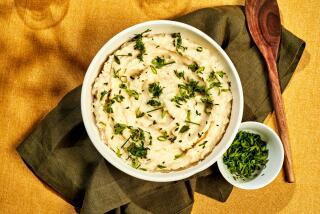A Potato Primer
- Share via
When it comes to mashed potatoes, there is little consensus about what is correct. The answers to questions such as the best utensil to use for mashing the spuds and whether they should or should not have lumps are strictly a matter of personal preference.
What does make a difference, however, is the variety used for mashing. Of the two basic types of potatoes--waxy and mealy (sometimes termed nonwaxy)--the latter is best suited for mashing because of its low sugar and high starch content.
If placed in a solution of one pound of salt in one gallon of water, waxy potatoes will float, while denser mealy potatoes will sink to the bottom. Unfortunately, this is not a very practical test to conduct while shopping, so generally speaking, rely on the thick-skinned potatoes such as russets to be mealy.
Select potatoes that are firm, free from large cuts, growth cracks and sprouting eyes. Avoid any with green-tinged skins.
According to “The Whole Potato Catalog,” a publication of the Potato Board, potatoes to be mashed may first be either boiled or steamed.
To Boil: In a heavy saucepan with tight-fitting lid, cook potatoes in about one inch of boiling, salted water until fork-tender. Whole, 30-40 minutes; cut-up, 20-25 minutes. (If lid doesn’t fit tightly, water may boil away, so check occasionally and add more water if necessary.)
To Steam: Place wire rack on bottom of a kettle or large saucepan and add water to just below the level of the rack. Bring the water to a boil, add potatoes and cook, tightly covered, until fork-tender. Whole, 30-45 minutes; cut-up, 20-30 minutes. (Check occasionally to see if water should be added, if lid is not tight-fitting.)
Most people prefer to peel potatoes before cooking, however this step can be done afterwards or, when using a ricer, may be eliminated to save time. During boiling, chunks of mealy varieties tend to slough off and the potatoes lose their shape. Once cooked, boiled potatoes should be drained well before mashing.
Milk, evaporated milk, half and half or cream may be used when mashing potatoes. Whatever the choice, it should be heated; adding cold liquid cools the potatoes and tends to make them gummy.
The more liquid used, the creamier and thinner the end product. The amount needed also varies depending on the potatoes; soil, climate and fertilizer used during growth all have their effects. Softened butter or margarine, salt and pepper are optional additions.
Use a potato masher, electric mixer or ricer to mash the potatoes. Following are techniques for using each device.
Potato Masher: Press the tool into the potatoes in a downward motion, forcing them through the cutting grid. Gradually add milk, butter and salt and pepper to taste, beating with the potato masher, fork or wire whisk until light and fluffy.
Electric Mixer: Begin by mashing the potatoes slightly with the stationary beaters. Turn the mixer on low speed and whip to the desired consistency, gradually adding milk, butter and salt and pepper to taste.
Ricer: Place the boiled potatoes in the perforated cylinder, then squeeze the long handles together to force the contents through the ricer holes. Let the rice-like pieces mound in the serving dish. Gradually add milk, butter and salt and pepper to taste and beat the potatoes with a fork, spoon or wire whisk until light and fluffy.
Most sources agree that mashed potatoes are best served immediately. If they must be held, spoon into a buttered casserole and smooth a light film of cream over the top. Keep warm in an oven heated to 250 degrees. Another technique is to set the pan of finished potatoes in a larger one of hot water. Cover with a towel to absorb the steam.


